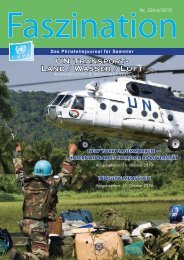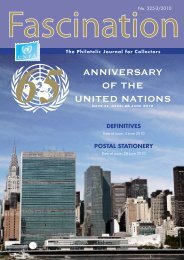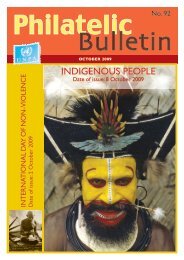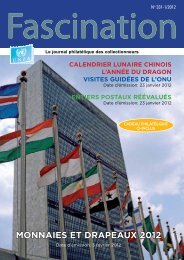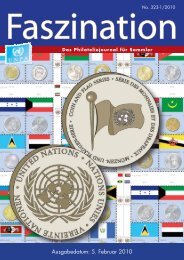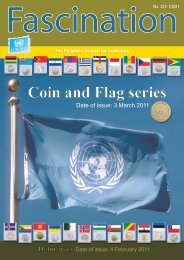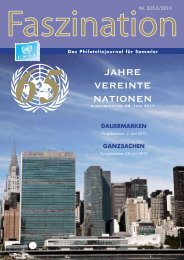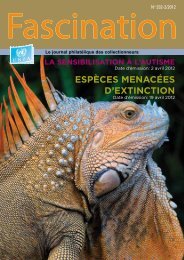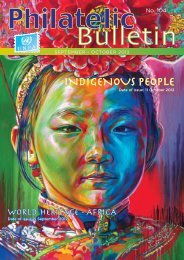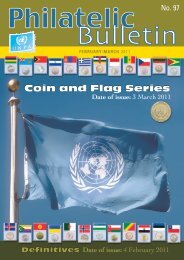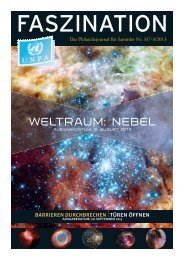Fascination 337 - United Nations Postal Administration - ONU
Fascination 337 - United Nations Postal Administration - ONU
Fascination 337 - United Nations Postal Administration - ONU
You also want an ePaper? Increase the reach of your titles
YUMPU automatically turns print PDFs into web optimized ePapers that Google loves.
Chuck Close, 2012<br />
Photograph by Gianffranco Gorgoni, courtesy the artist and Pace Gallery<br />
US$ 0.46<br />
Chuck Close (USA)<br />
Self-Portrait II (2010)<br />
Chuck Close is an award winning visual artist noted<br />
for his highly inventive techniques used to paint<br />
the human face. He is best known for his largescale,<br />
photo-based portrait paintings. He is also an<br />
accomplished printmaker and photographer whose<br />
work has been the subject of more than 200 solo<br />
exhibitions in more than 20 countries, including<br />
major retrospective exhibitions at New York’s<br />
Museum of Modern Art, The Metropolitan Museum<br />
of Art, the Museo Nacional Centro de Arte Reina<br />
Sofia in Madrid and most recently at the State<br />
Hermitage Museum in St. Petersburg, Russia. He has also participated in nearly<br />
800 group exhibitions.<br />
Though a rare spinal artery collapse in 1988 left him paralyzed, he has continued<br />
to paint using a brush-holding device strapped to his wrist and forearm.<br />
Mr. Close studied at the University of Washington School of Art (B.A., 1962) and<br />
at the Yale University School of Art and Architecture (B.F.A., 1963; M.F.A., 1964),<br />
receiving honorary degrees from both of his alma maters as well as 20 other<br />
institutions. Close is a member of the American Academy of Arts and Letters<br />
and has served on the board of many arts organizations.<br />
He was presented with the prestigious National Medal of Arts by President<br />
Clinton in 2000 and was appointed by President Obama to serve on The<br />
President’s Committee on the Arts and the Humanities.<br />
US$ 1.10<br />
Josephine King (<strong>United</strong> Kingdom)<br />
Tears And Laughter, France 2009,<br />
Ink on handmade paper<br />
My work is based on personal experience.<br />
My painting has progressed massively since I<br />
recovered from being severely ill and suicidal during<br />
a breakdown caused by my Bipolar illness. Since that<br />
experience my painting began to reach new depths<br />
that it never had before. I was newly compelled to<br />
express my darkest feelings and my work started to<br />
avalanche. Even if I had wanted to, I would not have<br />
been able to stop it's flow.<br />
When I am painting I reach a state of mind where I'm in another world, a world<br />
of unknown territory. I am not conscious of where I am. I paint through pure<br />
feelings. Hours go by, and when I awaken I hardly know where I've been. But<br />
then I see the painting in front of me.<br />
I use text in my paintings because I love to write as well as paint. I can express<br />
myself in both creative forms at the same time. They belong together, enhancing<br />
my story.<br />
After my first show, the Bipolar returned with a vengeance but it couldn't stop<br />
my work. In my second show, ‘I Told Him I Was An Artist. He Said “Can You<br />
Cook?”’ (Riflemaker 2012), I am concentrating on women's issues and particularly<br />
what it can feel like to be a female artist in the 21st Century. The title was taken<br />
from personal experience. I think it sums up a lot of attitudes towards women<br />
in general.<br />
My voice is just one amongst millions but if there are people who identify with<br />
my work and are moved by it, then I feel I have succeeded. I tell a personal<br />
story, yet if I depict pain or suffering it is universal. I paint from the heart and<br />
with honesty.<br />
Josephine King is represented by Riflemaker London<br />
CHF 1.40<br />
Sargy Mann (<strong>United</strong> Kingdom)<br />
See the girl with the red dress on,<br />
Oil on canvas 60” x 44”<br />
The British painter Sargy Mann was diagnosed<br />
with cataracts at 36, and went on to lose his sight<br />
completely. But in his mind's eye his vision did not<br />
fade. Mann found new ways to keep working and<br />
today his paintings, collected by Daniel Day-Lewis<br />
among others, are more acclaimed than ever.<br />
Even before he lost his sight, Sargy Mann was<br />
obsessed with ways of seeing. As a young painter<br />
he was tutored by singular realists – Frank Auerbach,<br />
Euan Uglow – who insisted that an individual artist must be exactly true to what<br />
he saw. For much of his working life Mann taught students at Camberwell School<br />
of Art all he knew about representing light and colour on canvas, with particular<br />
reference to Bonnard and Matisse, and he put all of that complex understanding<br />
into practice in his own, often gloriously sun-drenched landscapes and interiors.<br />
“I was saying to someone… how incredibly lucky I have been. I had about 25<br />
years’ apprenticeship for going blind. It was a bugger, but I kept working out<br />
how to paint over those 25 years, and my brain kept finding new ways to see the<br />
world...”<br />
Text excerpts from Tim Adams, “The Observer”<br />
CHF 1.90<br />
China Disabled People’s Performing Art Troupe (China)<br />
The China Disabled People's Performing Art Troupe was<br />
founded in 1987 to provide people living with disabilities a<br />
platform to express themselves in a special art. The Troupe's<br />
guiding principle is the pursuit of Truth, Honesty and Virtue<br />
which it emphasizes in all of its activities.<br />
The performers, with varying degrees of hearing, visual and physical disabilities,<br />
impart their glamour through dance and performances with spectacular sets and<br />
elegant, colourful costumes. The programme includes songs, Chinese classic<br />
dance, folk dance, ballet, Latin ballroom dance, modern dance, opera, jazz,<br />
instrumental music and poetry conveyed through sign language.<br />
For over twenty years, the China Disabled People’s Performing Art Troupe<br />
has produced extraordinary performances such as “My Dream” allowing<br />
the organization to travel to more than 80 countries. The cast of talented<br />
performers have been referred to as “Messengers of Beauty and Humanity”<br />
by the international community and “Ambassadors for People with Disabilities”<br />
by the Disabled People's World Assembly. They have also participated in the<br />
closing ceremonies of the Paralympic Games in Athens and the opening and<br />
closing ceremonies of the Paralympic Games in Beijing. The Troupe was also<br />
designated a “UNESCO Artist for Peace” by the <strong>United</strong> <strong>Nations</strong>.<br />
The artists are true professionals who dramatically illustrate the creative spirit<br />
and potential that lies at the heart of every person, regardless of physical<br />
challenges imposed through disability.<br />
€ 0.70<br />
Pete Eckert (USA)<br />
Electroman<br />
I didn’t take photography seriously until I went totally<br />
blind. I was trained in sculpture and industrial design.<br />
I have always been a visual person and planned to<br />
study architecture at Yale, but then I started to lose<br />
my sight. A doctor coolly told me I had Retinitis<br />
Pigmentosa and left the room without further<br />
comment. I learned a person with RP gradually looses<br />
their sight until they go completely blind. There is<br />
currently no cure for RP.<br />
I was on my own to find a path. It took me two years to<br />
recover and figure out what to do. My first photography outing after a thousand<br />
questions at the camera store started it all. People liked the photos. I had found<br />
a medium.<br />
I view my work during the event of taking the shot in my mind’s eye. I “see” each<br />
shot very clearly, only I use sound, touch and memory. I am more of a conceptual<br />
artist than a photographer. My influences come from my past memory of art and<br />
what I now find in the world at large.<br />
I am trying to cut a new path as a blind visual artist. It is important to me that<br />
the sighted think about blindness. What I get out of taking photos is the event<br />
not the picture. I do the large prints to get sighted people thinking. Talking with<br />
people in galleries builds a bridge between my mind’s eye and their vision of<br />
my work. Occasionally people refuse to believe I am blind. I am a visual person.<br />
I just can’t see.<br />
€ 1.70<br />
Matt Sesow (USA)<br />
Dive Bomb<br />
Born in 1966, Matt Sesow was raised in rural Nebraska<br />
while enjoying a normal childhood. On a summer<br />
evening when he was eight at an airfi eld near his<br />
home, he was struck by the propeller of a landing<br />
airplane. The accident resulted in his left arm being<br />
severed and the loss of his left hand. Through the<br />
support of his family, Matt’s physical disability was<br />
minimized as he was encouraged to participate in a<br />
variety of academic and organized sporting events.<br />
Eventually he attended and graduated University<br />
with a degree in Computer Information Systems and<br />
a professional career with IBM as a software tester.<br />
Without formal art education, Matt Sesow discovered painting as a hobby while<br />
working at IBM. In the evenings and on weekends he played with painting and<br />
12 unstamps.org



